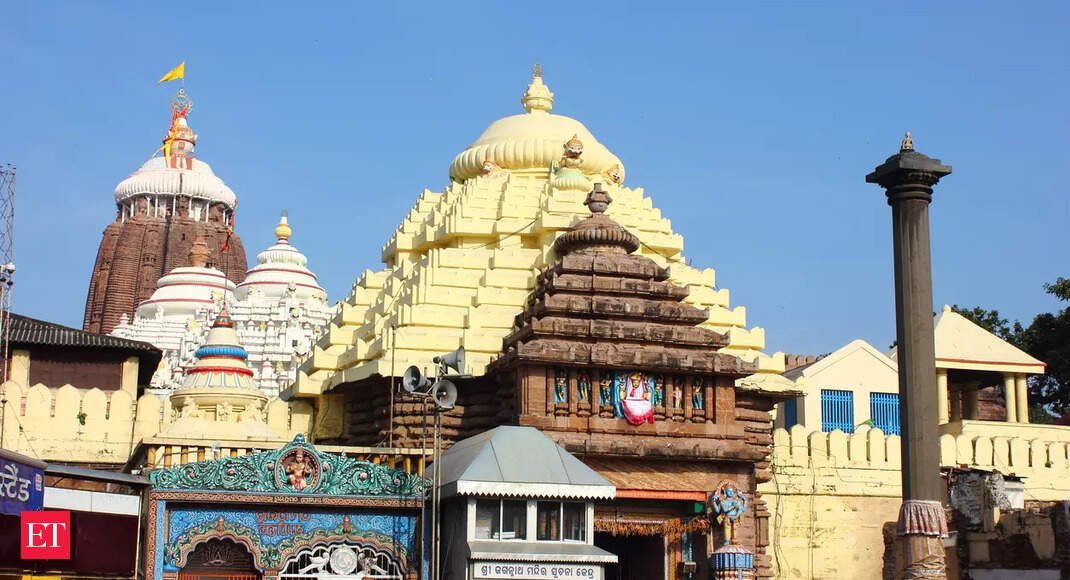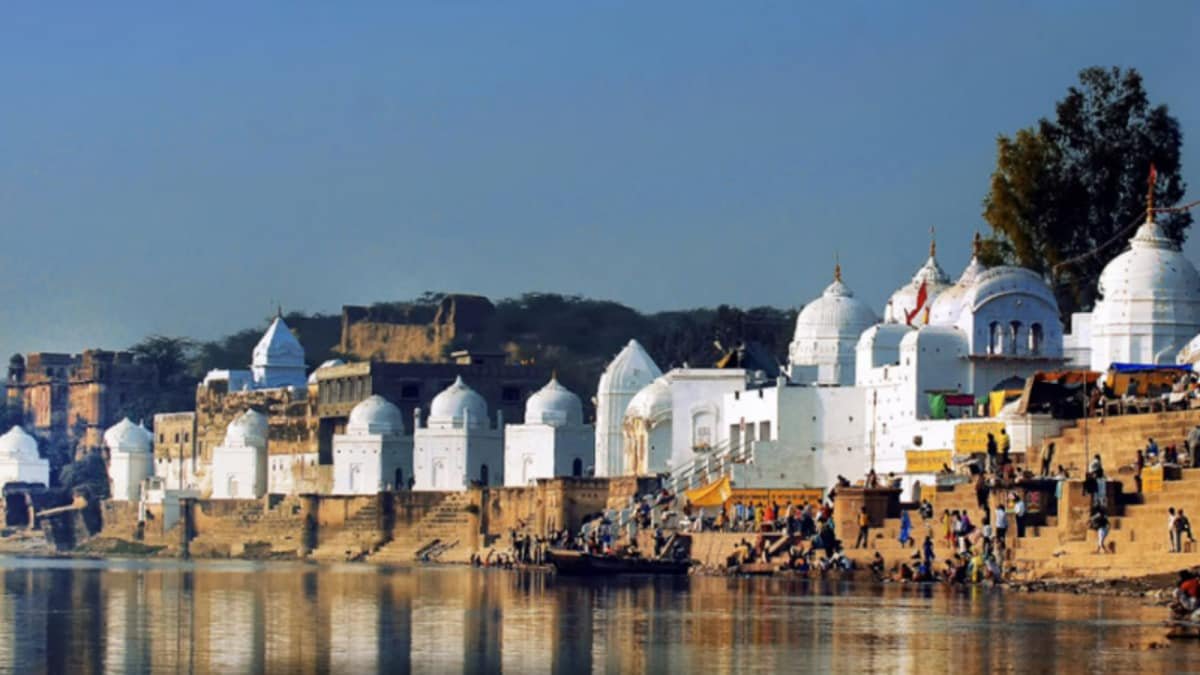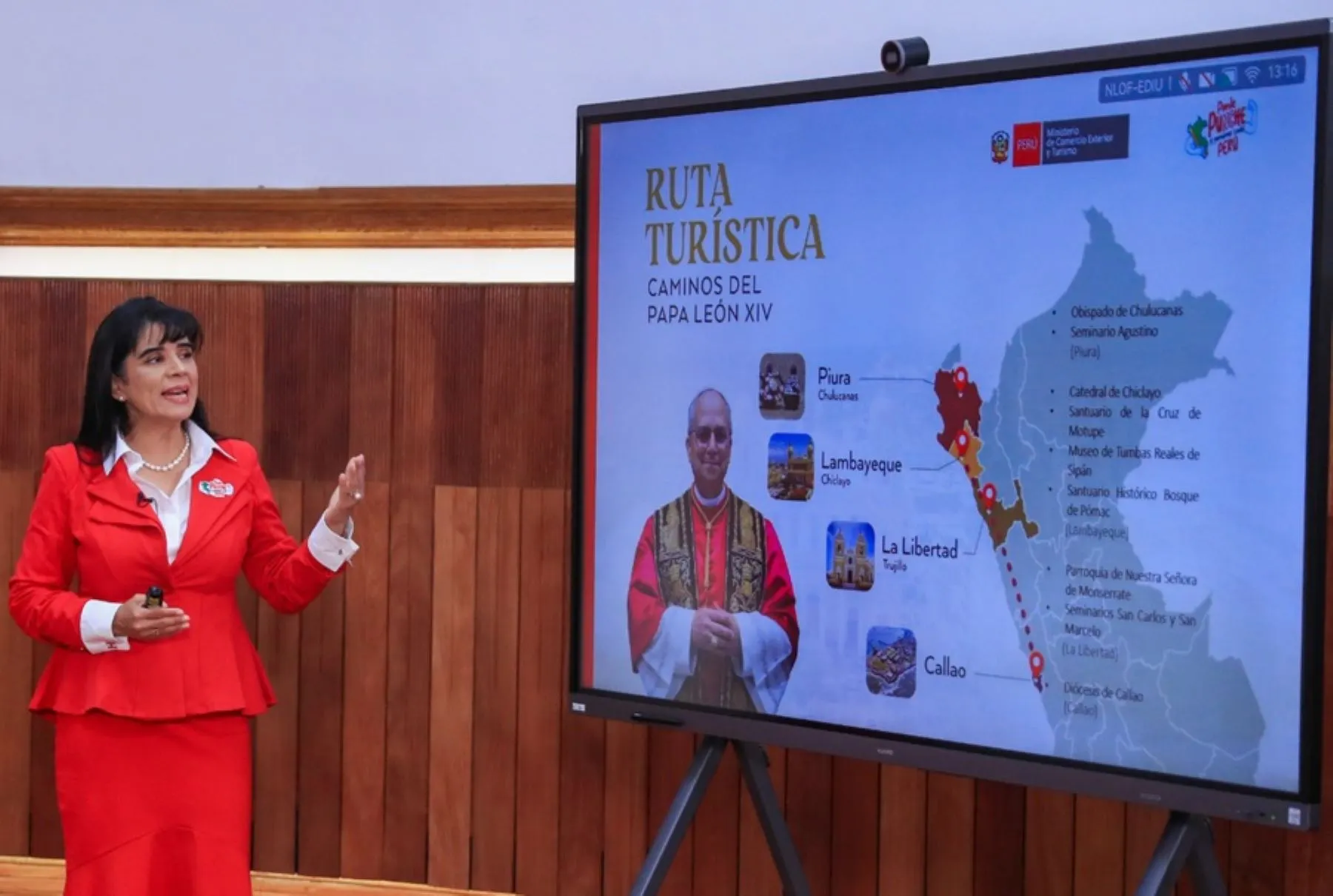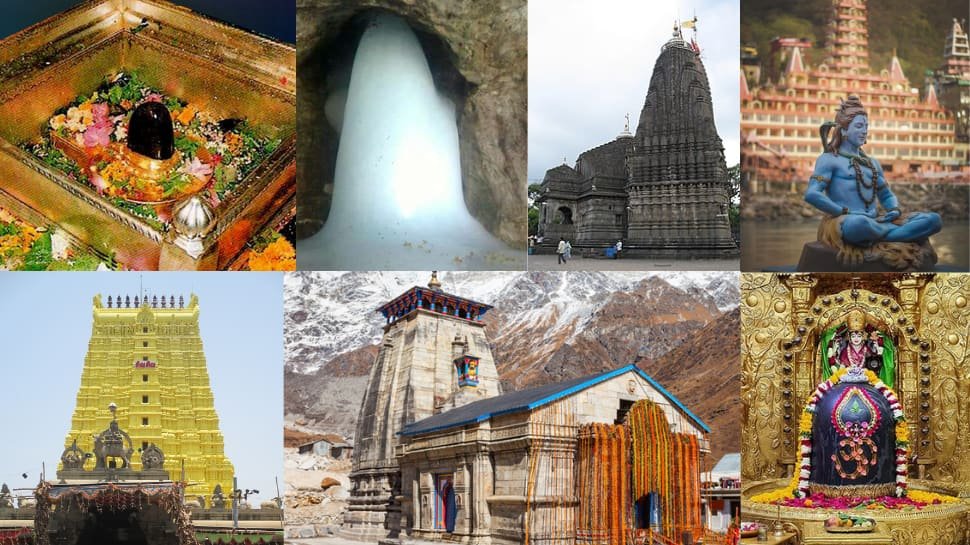Spiritual Travel
6 sacred places to visit in Puri during Jagannath yatra – The Economic Times

6 sacred places to visit in Puri during Jagannath yatra The Economic Times
Source link
Spiritual Travel
Temples, Tourism, Tribute: Atal Bihari Vajpayee’s Village Bateshwar Set For Grand Makeover | India News

The Bateshwar Blueprint
Tourism department officials revealed that the Rs 27 crore package will be allocated to various components to improve spiritual infrastructure, ease access for pilgrims, and enhance civic amenities. Of the total allocation, Rs 19 crore will be dedicated to renovating the ghats, stretching from the revered Gopaleshwar Mahadev Temple to the cultural complex on the riverfront. The upgrades will include beautification, strengthening of embankments, safe access steps, aesthetic lighting, and viewing decks. “The ghats are the heart of religious activity here, especially during the annual Bateshwar Fair. This facelift will make pilgrimages safer and more enriching,” said Ashutosh Kumar, Assistant Director, Uttar Pradesh Tourism Department.
To give Bateshwar a distinguished entry, two imposing gateways will be constructed—one on the Firozabad Road and the other along the Agra-Lucknow Expressway. Designed to reflect the local cultural ethos and traditional temple motifs, these entrances will cost Rs 5 crore in total. Additionally, Rs 1 crore has been earmarked for installing modern eco-tourism signage in the Rapri region, which borders the National Chambal Sanctuary. “These signages will not only aid navigation but also introduce visitors to the region’s diverse heritage – spiritual, natural, and historical,” Kumar added.
Basic infrastructure improvements worth Rs 2 crore will cover internal roads, street lighting, sanitation, and parking areas. “Our aim is to make Bateshwar clean, accessible, and welcoming for all,” he said.
A Big Move for Locals
For the residents of Bateshwar, the announcement has brought a wave of excitement and hope. “This is the biggest thing to happen to our village in years,” said Rajendra Vajpayee, a distant relative of the former PM who still resides in the original Vajpayee family home. “Atalji never forgot Bateshwar, and now the state is remembering him through this project. It feels like justice to his memory,” he added.
Shopkeeper Shivam Tiwari, whose small stall sells puja items near the ghats, believes the changes will attract more visitors and improve livelihoods. “During the annual fair, lakhs come, but for the rest of the year, it’s quiet. With new roads, lighting, and signs, even off-season tourism will improve,” he said.
Schoolteacher Manorama Mishra, who also runs a local heritage club for students, hopes the plan will also preserve the ecological sanctity of the area. “The Yamuna here is still relatively clean. It’s not like what you see in cities. If development is done sensitively, it can become a model of eco-spiritual tourism,” she said.
What Does the Tourism Minister Say?
Tourism and Culture Minister Jaiveer Singh stated that the project is part of a broader initiative to decentralise tourism in Uttar Pradesh and bring attention to lesser-known spiritual and cultural sites. “Agra is synonymous with the Taj Mahal globally, but there is so much more in this region. Bateshwar, with its temple heritage and its connection to one of India’s tallest leaders, deserves prominence,” said Singh. He mentioned that new tourism circuits are being developed, which include Kannauj, Braj, and now Bateshwar, aimed at empowering local communities and preserving cultural traditions.
Officials noted that the new travel circuit aims to attract not only domestic pilgrims but also international tourists seeking authentic cultural experiences beyond mainstream destinations. The UP Tourism department indicated that work on the project is expected to begin later this year, once detailed tenders and conservation plans are finalised. The district administration has already initiated preliminary surveys, and coordination with the Archaeological Survey of India (ASI) is underway for work near protected monuments.
As Bateshwar prepares to welcome a new wave of pilgrims and tourists, residents are hopeful that the transformation will not only boost their economy but also reaffirm the cultural and spiritual identity of a village closely tied to one of India’s most beloved leaders. “Bateshwar has waited long for its due. Maybe now, under the light of these 101 temples and Atalji’s legacy, our time has come,” said 78-year-old Ram Dayal Dubey, a retired school principal and lifelong devotee at the ghats.
Spiritual Travel
Peru Bets on Pope Leo XIV Tourism to Boost Local Economies (58 characters)

Peru is betting big on the legacy of a pope who walked among its most vulnerable communities. The government has unveiled an ambitious $150 million tourism initiative called the “Paths of Pope Leo XIV,” spotlighting over 35 sites where Robert Prevost lived and worked for nearly four decades before ascending to the papacy. This transformative project aims to restore historic landmarks, boost local economies, and share profound stories of resilience from Peru’s hardest-hit regions. As workers begin revitalizing churches, museums, and infrastructure across Lambayeque, La Libertad, Piura, and Callao, officials envision a route that honors both spiritual heritage and human perseverance—a testament to how one man’s grassroots service could ignite nationwide renewal.
Peru’s Ambitious “Paths of Pope Leo XIV” Initiative: A $150 Million Tourism Transformation
Peru’s Ministry of Foreign Trade and Tourism has committed unprecedented resources to the “Paths of Pope Leo XIV” project, targeting strategic upgrades across northern coastal regions. The $150 million investment—one of Peru’s largest tourism infrastructure packages in a decade—will restore colonial-era churches damaged by natural disasters, modernize regional museums with interactive exhibits about Pope Leo XIV’s work, and improve roads, signage, and visitor centers.
Economic recovery sits at the heart of this initiative. Tourism Minister Juan Carlos Mathews emphasized, “This isn’t just about preserving history—it’s about creating jobs.” The project targets 5,000 new positions for local guides, artisans, and hospitality workers in areas where poverty rates exceed 30%. Early modeling by Peru’s National Institute of Statistics and Informatics (INEI) suggests the route could attract 250,000 annual visitors within five years, generating $60 million in regional income.
Strategic Site Restoration and Community Integration [H3]
Restoration teams are prioritizing locations where Pope Leo XIV’s humanitarian efforts left indelible marks:
- Lambayeque: Rebuilding the 18th-century San Pedro Church where Prevost sheltered flood victims
- La Libertad: Modernizing the Trujillo Community Center that distributed aid during economic crises
- Piura: Creating a memorial garden at the site where Prevost mediated during political unrest
- Callao: Installing bilingual exhibits at the Port of Callao Museum documenting his arrival
Local craftspeople are commissioned to produce route-related souvenirs, ensuring economic benefits stay within communities. As Piura artisan Elena Quispe noted while weaving textiles for visitor centers, “This route tells our story—not just the Pope’s.”
The Enduring Legacy of Pope Leo XIV in Peru’s Most Vulnerable Regions
Before becoming Pope Leo XIV in 2023, Robert Prevost spent 40 years serving Peru’s marginalized communities. His work coincided with some of the nation’s darkest hours—including catastrophic El Niño floods in 2017 that killed 162 people and displaced 700,000. Prevost coordinated rebuilding efforts in Lambayeque, famously wading through mud to distribute supplies when roads were impassable.
During Peru’s 2020 economic collapse under COVID-19, he organized food banks in La Libertad, where malnutrition rates surged. Later, as violence flared during the 2022 political crisis, he brokered truces between protestors and security forces in Piura. These actions cemented his reputation as “the people’s priest”—a legacy Peru now honors through tourism.
Beyond Pilgrimage: Blending Faith, Culture and Ecology
Unlike traditional religious routes, the “Paths of Pope Leo XIV” weaves together spiritual, cultural, and ecological experiences:
- Faith: Meditation gardens at churches where Prevost preached
- Culture: Workshops with indigenous Moche potters in La Libertad
- Ecology: Birdwatching tours in Piura’s restored wetlands, which Prevost championed
- Cuisine: Farm-to-table meals using recipes from soup kitchens he established
“This route shows how faith translates into action,” explains historian Dr. Felipe Zegarra of Lima’s Pontifical Catholic University. “Prevost didn’t just build churches—he rebuilt societies.”
Economic Revival: Turning Papal Legacy into Sustainable Growth
Peru’s gamble extends beyond tourism. The project aims to catalyze long-term investment in regions where infrastructure gaps hinder development. By upgrading roads, water systems, and digital connectivity along the route, the government hopes to attract agribusiness and manufacturing ventures.
Hotel chains like Libertador and Casa Andina have already announced properties near key sites. Meanwhile, tech startups are developing AR apps that overlay Prevost’s humanitarian work onto modern landscapes. As Trade Minister Elizabeth Galdo stated, “We’re creating an ecosystem where tourism revenue funds schools and clinics—exactly as Pope Leo XIV would have wanted.”
Peru’s “Paths of Pope Leo XIV” demonstrates how honoring one man’s legacy can ignite collective hope. By transforming sites of struggle into destinations of inspiration, this $150 million initiative weaves together threads of faith, resilience, and economic revival. For travelers seeking more than scenery—for those drawn to places where compassion changed history—this route offers a profoundly human journey. Discover the path for yourself at Peru.Travel and witness how a nation rebuilds through memory.
Must Know
What is the “Paths of Pope Leo XIV” tourist route?
Peru’s government-designed cultural and religious trail spans over 35 sites across four regions (Lambayeque, La Libertad, Piura, Callao) linked to Pope Leo XIV’s 40-year humanitarian work. The $150 million project restores churches, museums, and infrastructure while creating jobs and honoring his legacy of community service.
Why is Peru investing so heavily in this route?
Beyond preserving history, Peru aims to boost tourism in economically struggling regions. Officials project 250,000 annual visitors within five years, generating $60 million for local communities. The route also improves roads and utilities to attract broader investment.
Who was Pope Leo XIV before becoming pope?
Born Robert Prevost, he spent nearly four decades serving Peru’s poor. He rebuilt towns after catastrophic floods, provided famine relief, mediated conflicts during political unrest, and supported indigenous communities—actions that defined his “people’s priest” reputation.
Is this route only for religious pilgrims?
No. While including spiritual sites, the experience blends cultural workshops (like Moche pottery), ecological activities (wetland birdwatching), and historical exhibits. It’s designed for travelers interested in Peru’s social resilience as much as its faith.
When will the route open to visitors?
Phase one sites in Lambayeque and La Libertad will open by late 2024. Full completion across all four regions is slated for mid-2026. Restoration progress can be tracked via Peru’s Ministry of Culture website.
How can tourists support local communities along the route?
Choose community-run lodges, hire local guides, purchase crafts directly from artisans, and dine at restaurants sourcing from nearby farms. Revenue stays within regions when services are booked through official route partners.
Spiritual Travel
11 Most Powerful Shiva Temples To Visit On Sawan Shivratri 2025 – Number 7 Will Leave You Spellbound | News

Sawan Shivratri 2025 is more than just a holy date, it’s a divine invitation to connect with Lord Shiva’s powerful energy. What better way to celebrate than visiting sacred temples where His presence is said to be most potent? From mystical caves to sky-touching jyotirlingas, each temple on this list holds ancient secrets and miracles. Get ready to awaken your soul – number 7 might just change your life forever!
Experience Divine Bliss This Sawan Shivratri
1/17
Sawan Shivratri 2025, being celebrated today, Wednesday, July 23, is a sacred opportunity to immerse yourself in devotion to Lord Shiva. Considered one of the holiest nights in Hinduism, Shivratri during the Shravan month holds immense spiritual potency. And what better way to observe it than by visiting one of the many revered Shiva temples across India?
Shivratri Spiritual Destinations
2/17
From towering Jyotirlingas to mystic Himalayan shrines, these temples are not just places of worship—they are gateways to spiritual transformation. Here are the Top 11 Shiva Temples to visit this Sawan Shivratri for blessings, peace, and inner awakening.
Kashi Vishwanath Temple, Varanasi (Uttar Pradesh)
3/17
One of the most revered Jyotirlingas, the Kashi Vishwanath Temple stands on the banks of the holy Ganga in the world’s oldest living city. Sawan Shivratri here is a spiritual spectacle—millions of devotees perform jalabhishek, chant “Har Har Mahadev,” and feel Shiva’s presence in every breath. The atmosphere is electrifying with bhajans, incense, and sacred rituals.
Kedarnath Temple, Uttarakhand
4/17
Nestled in the lap of the Garhwal Himalayas, Kedarnath is not just a temple—it’s an experience of surrender and silence. This ancient shrine, accessible only during summer months, holds deep mythological significance. On Sawan Shivratri, the divine energy feels more intense with chilling winds, snowy peaks, and soul-stirring chants echoing through the mountains.
Mahakaleshwar Temple, Ujjain (Madhya Pradesh)
5/17
Famed for its Bhasma Aarti, the Mahakaleshwar Temple is a Jyotirlinga that draws thousands on Shivratri. The deity here is believed to be swayambhu (self-manifested), and devotees say their sins are burned away in the fire of Mahakaal’s blessings. On Sawan Shivratri, the temple is decorated with flowers and lights, offering a surreal spiritual high.
Somnath Temple, Gujarat
6/17
Rebuilt several times, Somnath is a symbol of resilience and devotion. As the first of the 12 Jyotirlingas, it marks the sacred union of faith and history. During Sawan Shivratri, the temple sees a surge in pilgrims who gather on the western coast to offer water, milk, and prayers to Shiva, believing that every act here washes away lifetimes of karma.
Baidyanath Dham, Deoghar (Jharkhand)
7/17
Also known as Baba Dham, this is where Ravana offered his ten heads to please Lord Shiva. It is one of the most visited temples during Shravan, with devotees walking miles barefoot in the Kanwar Yatra. On Sawan Shivratri, the devotion peaks—chanting fills the air, and the energy is transformative. It is said that prayers here never go unanswered.
Ramanathaswamy Temple, Rameswaram (Tamil Nadu)
8/17
This Dravidian-style temple, associated with Lord Rama’s penance to Shiva, is known for its longest temple corridor in the world. A dip in the 22 theerthams (holy wells) followed by darshan of the Shiva Lingam is a purifying ritual. Sawan Shivratri here brings together devotees from across South India, uniting traditions in one sacred space.
Trimbakeshwar Temple, Nashik (Maharashtra)
9/17
Located near the origin of the Godavari River, this Jyotirlinga is famous for its three-faced Lingam symbolizing Brahma, Vishnu, and Shiva. On Sawan Shivratri, the temple comes alive with holy baths, Rudrabhishekams, and traditional music. It is also considered ideal for Pitru rituals, making it spiritually enriching on multiple levels.
Amarnath Cave Temple, Jammu & Kashmir
10/17
This cave shrine, where the naturally-formed ice Shivlinga appears during Sawan, is one of the most sacred pilgrimage sites. Accessible only through a treacherous trek, visiting Amarnath on Shivratri is a once-in-a-lifetime experience. Chanting amidst snow-covered peaks, under star-lit skies, creates an unmatched connection with Lord Shiva.
Lingaraj Temple, Bhubaneswar (Odisha)
11/17
One of the oldest temples in the East, the Lingaraj Temple is a masterpiece of Kalinga architecture. It beautifully blends the traditions of Shaivism and Vaishnavism. On Sawan Shivratri, rituals start early, and the temple premises glow with diyas and mantras. The vibe is peaceful, making it ideal for meditative darshan.
Tungnath Temple, Uttarakhand
12/17
The highest Shiva temple in the world, Tungnath is part of the Panch Kedar pilgrimage. A moderate trek leads to this secluded shrine where the air is crisp, and the silence speaks volumes. Sawan Shivratri at Tungnath is intimate—a few hundred pilgrims, snow-kissed stones, and the inner voice of Shiva guiding every step.
Tarakeshwar Temple, West Bengal
13/17
Popularly known as “Baba Taraknath,” this temple near Kolkata is a hub for Bengali devotees. On Sawan Shivratri, the temple witnesses a massive influx of pilgrims offering gangajal, bel leaves, and chanting mantras with fervor. The temple is known for fulfilling wishes related to health, prosperity, and family life.
Lord Shiva Pilgrimage
14/17
Sawan Shivratri is more than a date—it’s a divine invitation to turn inward, seek blessings, and realign with your higher self.
Spiritual Places for Shivratri
15/17
Whether you visit one of these 11 iconic temples or simply chant mantras at home, the intention of surrender and devotion is what truly connects you to Lord Shiva.
Mahadev Temples India
16/17
Take a spiritual journey—through mountains, rivers, caves, and temples—and find Shiva within you. Har Har Mahadev!
Shiva Devotee Travel Guide
17/17
(This article is intended for your general information only. Zee News does not vouch for its accuracy or reliability.)
(Pic Credits: Freepik, Wikipedia)
-

 Brand Stories2 days ago
Brand Stories2 days agoBloom Hotels: A Modern Vision of Hospitality Redefining Travel
-

 Brand Stories1 day ago
Brand Stories1 day agoOlive Living: India’s Intelligent, Community-Centric Hospitality Powerhouse
-

 Destinations & Things To Do3 days ago
Destinations & Things To Do3 days agoUntouched Destinations: Stunning Hidden Gems You Must Visit
-

 AI in Travel3 days ago
AI in Travel3 days agoAI Travel Revolution: Must-Have Guide to the Best Experience
-

 Brand Stories3 weeks ago
Brand Stories3 weeks agoVoice AI Startup ElevenLabs Plans to Add Hubs Around the World
-

 Brand Stories2 weeks ago
Brand Stories2 weeks agoHow Elon Musk’s rogue Grok chatbot became a cautionary AI tale
-

 Asia Travel Pulse3 weeks ago
Asia Travel Pulse3 weeks agoLooking For Adventure In Asia? Here Are 7 Epic Destinations You Need To Experience At Least Once – Zee News
-

 AI in Travel3 weeks ago
AI in Travel3 weeks ago‘Will AI take my job?’ A trip to a Beijing fortune-telling bar to see what lies ahead | China
-

 Brand Stories3 weeks ago
Brand Stories3 weeks agoChatGPT — the last of the great romantics
-

 Brand Stories2 weeks ago
Brand Stories2 weeks agoHumans must remain at the heart of the AI story
